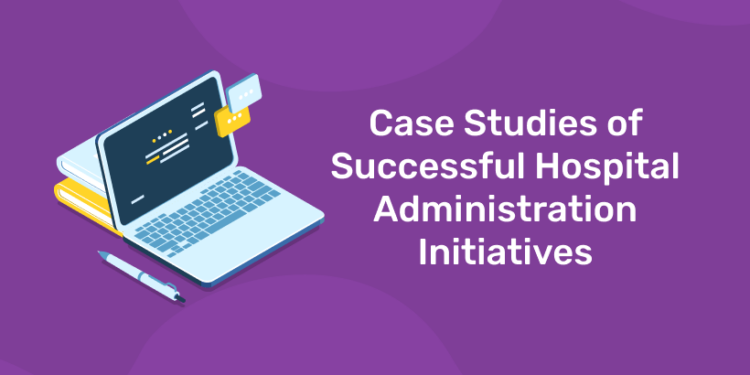Table of Contents
Healthcare is a fast paced environment and hospital administrators need to be able to manage resources and navigate the complex ethical issues that arise every day. Effective hospital management is a balance between being operationally efficient and ethically sound. This blog post looks at real life case studies of hospital administration and initiatives that have made a difference to healthcare. By looking at these examples we can learn and borrow some strategies to improve hospital operations. And continuous education and professional development is key to equipping hospital administrators with the skills to tackle the ethical dilemmas and improve overall hospital management.
Case Study 1: Lean Management in Healthcare
Background
A major city hospital was experiencing long patient wait times, resource wastage and increasing operational costs. The management decided to implement Lean Management to simplify operations and improve patient care.
Initiative
The hospital management formed a multi disciplinary team to map out current processes and identify areas of waste. They used Lean tools like value stream mapping, 5S (Sort, Set in order, Shine, Standardize, Sustain) and Kaizen (continuous improvement).
Results
- Wait Times: 30% reduction in patient wait times
- Cost Savings: 15% reduction in operational costs through better resource utilization
- Patient Satisfaction: 20% increase in patient satisfaction
Key Takeaways
- Get staff from different departments involved in process improvement initiatives for more holistic solutions
- Continuous monitoring and tweaking of processes is key to sustaining improvements.
Explore Your Future in Healthcare Management! Enroll now
Case Study 2: Using Technology to Improve Patient Safety
1: What is the primary role of a hospital administrator?
Background
A medium sized hospital was experiencing high medication errors which was a big risk to patient safety. The management decided to use technology to address this.
Initiative The management implemented an electronic health record (EHR) system with computerized physician order entry (CPOE) and barcode medication administration (BCMA).
Results
- Reduction in Medication Errors: 50% reduction in medication errors
- Increased Efficiency: Nurses and pharmacists reported more efficient medication administration and inventory management
- Better Communication: Improved communication between healthcare providers led to better patient care
Key Takeaways
- Technology can make a big difference to patient safety and operational efficiency
- Training and ongoing support for staff is key to successful implementation and adoption of new technology.
Hospital Administration Course with Assured Career Growth
Hospital Administration Course by Entri App: Master essential healthcare management skills, gain certification, and secure top roles in leading hospitals
Join Now!Case Study 3: Financial Performance through Revenue Cycle Management
Background
A rural hospital was financially struggling due to poor revenue cycle management. The hospital administration knew they needed to overhaul their billing and collection process to improve cash flow and financial performance.
Initiative The administration partnered with a revenue cycle management consulting firm to re-engineer their billing process, implement advanced analytics and train staff on best practices.
Results
- Increased Revenue: 20% increase in revenue in the first year.
- Improved Cash Flow: 25% decrease in days in accounts receivable.
- Increased Staff Productivity: Staff productivity increased due to streamlined billing process and less administrative burden.
Key Takeaways
- Revenue cycle management is key to a hospital’s financial health.
- Partner with experts and invest in staff training and you’ll see big financial results.
Case Study 4: Expanding Access to Care through Telemedicine
Background
A community hospital in a rural area had challenges in providing timely access to specialty care. The hospital administration decided to launch a telemedicine program to expand access to care.
Initiative Invested in telemedicine technology and partnered with specialists in urban centers to provide virtual consults and follow up care for patients in the community.
Results
- Access to Care: Patients had access to specialty care without the need to travel long distances.
- Cost Savings: Reduced travel costs and no patient transfers to other facilities.
- Better Health Outcomes: Timely access to specialist consults resulted in better management of chronic conditions and better health outcomes.
Key Takeaways
- Telemedicine can fill the gap in specialty care especially in remote and underserved areas.
- Partner with external specialists and invest in technology to make telemedicine work.
Case Study 5: ED Operations
Background
A large urban hospital’s ED was overcrowded and had long wait times, patient dissatisfaction and operational inefficiencies. The administration decided to re-engineer ED operations to improve patient flow and care.
Initiative Introduced fast track for less acute cases and real time data analytics to monitor patient flow and resource allocation. ED staff were trained on triage protocols and patient communication.
Results
- Wait Times: 40% reduction in wait times.
- Patient Flow: Better triage and patient processing improved overall patient flow.
- Patient Satisfaction: Patient satisfaction scores in the ED improved.
Key Takeaways
- Real time data analytics can give you insights to improve patient flow and resource management.
- Train your staff to make process improvements work.
Hospital Administration Course with Assured Career Growth
Hospital Administration Course by Entri App: Master essential healthcare management skills, gain certification, and secure top roles in leading hospitals
Join Now!Case Study 6: Staffing Solutions through Flex Scheduling
Background
A hospital was experiencing staffing shortages and high turnover rates affecting patient care and staff morale. The administration wanted to solve this problem with creative staffing solutions.
Initiative The hospital introduced flex scheduling and created a float pool to cover absences and peak times. They also implemented a staff wellness program to increase job satisfaction and retention.
Results
- Turnover Rates Down 25%
- Coverage Improved: Flex scheduling ensured coverage during peak times and absences.
- Job Satisfaction Up: Staff said they were more satisfied with their jobs due to work-life balance and wellness initiatives.
Key Takeaways
- Flex scheduling and support systems can solve staffing problems and retention.
- Investing in staff wellness programs means higher job satisfaction and better patient care.
Explore Your Future in Healthcare Management! Enroll now
Continuous Education
Continuous education is key for hospital administrators to stay up to date with the latest trends, technologies and best practices in healthcare management. Ongoing professional development helps administrators handle complex ethical issues, improve operational efficiency and implement solutions effectively.
Entri’s Hospital and Healthcare Administration Course
For those wanting to further develop their skills and knowledge in hospital administration, continuous education and professional development is crucial. Entri’s Hospital and Healthcare Administration Course provides comprehensive training and resources to help hospital administrators navigate the complexities of healthcare management and lead their organizations to success. Practical skills and real world applications are the focus of this course to equip healthcare professionals with the tools they need to succeed in their roles and make a difference to patient care and operational efficiency.
Conclusion
The case studies in this post show the many ways hospital administrators can improve operational efficiency, patient safety, financial performance and access to care. These real life examples show the importance of innovation, collaboration and continuous improvement in hospital administration.
By learning from these examples hospital administrators can identify and implement best practices that fit their own challenges and goals. Whether it’s Lean Management, technology, revenue cycle management or telemedicine, there are many ways hospital administrators can make a positive impact in their organization.
In conclusion, successful hospital administration requires a proactive and strategic approach to managing resources, processes, and people. By embracing innovation and continuous improvement, hospital administrators can create a culture of excellence that benefits both patients and staff.
Hospital Administration Course with Assured Career Growth
Hospital Administration Course by Entri App: Master essential healthcare management skills, gain certification, and secure top roles in leading hospitals
Join Now!Frequently Asked Questions
What are some key strategies for improving operational efficiency in hospitals?
Key strategies include implementing Lean Management principles, leveraging technology for better resource utilization, streamlining revenue cycle management, and adopting flexible staffing solutions.
How can technology enhance patient safety in hospitals?
Technology can enhance patient safety through electronic health records (EHR), computerized physician order entry (CPOE), and barcode medication administration (BCMA), reducing medication errors and improving communication among healthcare providers.
What are the benefits of continuous education for hospital administrators?
Continuous education helps administrators stay updated with the latest trends, technologies, and best practices, enabling them to handle ethical issues, improve operational efficiency, and implement innovative solutions effectively.
How can hospital administrators address staffing challenges?
Administrators can address staffing challenges by introducing flexible scheduling options, creating a pool of float nurses, and implementing staff wellness programs to improve job satisfaction and retention.
How can telemedicine improve access to care in remote areas?
Telemedicine can bridge the gap in access to specialized care by enabling virtual consultations and follow-up care, reducing travel costs, and minimizing the need for patient transfers to other facilities, leading to better health outcomes.
How do hospital administrators ensure compliance with healthcare regulations?
Administrators ensure compliance by staying informed about current regulations, conducting regular audits, implementing robust policies and procedures, and providing ongoing staff training on compliance issues.












